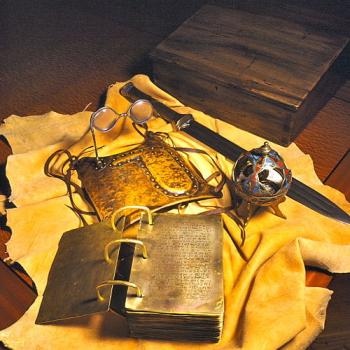Lectionary Reflections
Fifth Sunday of Easter
John 14:1-14
May 22, 2011
Embarrassed in Class
A few years ago I took an introductory Spanish course at a local community college. The teacher had two strengths and two faults. Her two strengths were that she was lively and knowledgeable. Her two faults were that she couldn't keep straight which level she was teaching, and she did not try to hide her displeasure when someone answered a question incorrectly or asked for clarification of something she'd said. We started out with twenty students and, by the end, there were five of us left.
She taught six one semester Spanish classes: level 1, 2, 3, 4, 5, and 6. Sometime she would slip several stitches on her mental loom and jump from Spanish 1 to Spanish 6 in the middle of class. The second class she called on me, "Señora McKenzie," and demanded that I answer a multiplication question that involved numbers higher than 100. There were two problems with that. The first one is that I'm not very good at multiplication even in English. The second was that we had only gotten to the chapter in our introductory textbook Que Tal? that covered the numbers 1-30. I broke into a sweat, turned red, and looked down. I knew chastisement was imminent. She taught me some Spanish. She also reinforced a couple of principles I've since tried harder than ever to follow in my own teaching: 1) Don't assume knowledge that your students don't have, and 2) Do not chastise students in front of others.
Jesus Takes the Disciples to School
A quick read through John 14:1-14 might make me think Jesus was a lot like my Spanish teacher. He assumes knowledge his disciples don't have, telling Thomas, "You know the way to the place I am going" (14:4). Then, when Thomas objects, "Lord, we do not know where you are going. How can we know the way?" Jesus takes him to school with his "I am the Way" monologue.
He chastises both Simon Peter and Philip in front of the whole group.
Simon Peter must have broken into a sweat, turned red, and looked down, stung by Jesus' public prediction that he would betray him three times (13:38). All he had done was ask a couple of innocent questions: "Lord, where are you going?" and "Why can't I follow you?" (13:36-38).
Philip makes a reasonable request on behalf of the group: "Show us the Father, and we will be satisfied." Jesus chastises him in front of the whole group: "Have I been with you all this time, Philip, and you still do not know me?" (14:9).
It turns out that Jesus is not an ineffective teacher. We are just slow to catch on. Yes, he's a little blunt in his corrections in this passage, but chapters 14-17 of John's Gospel are not called the farewell discourse for nothing. He's leaving and they need to know the Way. The time has grown short. The hour is near. The clock has run out on subtlety. Jesus, in John 14:1-10, isn't skipping up to the level six discipleship class with a class of newbies. Simon Peter, Thomas, and Philip have been with him three years. Jesus is attempting to teach a level six discipleship course with students who were in their sixth semester.
Questions Disciples Still Ask
Normally the question-and-answer time comes after the public lecture. But in this case, it comes first. Simon Peter, Thomas, and Philip all make comments and ask questions (13:36-14:8). From 14:9 through 16:29, Jesus does all the talking. The disciples fall silent. I wonder if they might have been wary of speaking up, after Jesus' responses to their initial questions and requests. Because in 13:38-14:8, they ask two questions they should already know the answer to.
- How can we know the way to God?
- How are we to see the Father?"
The disciples' questions in 14:1-9 are meant, in John's narrative flow, to represent our questions. You and I may have been students of Jesus for quite a while, but we still sit in the school of life sometimes feeling out of our depth in the face of life's enigmas and trials. We still ask the basic questions:
"How can we know the way to God?" and "How are we to see God?"
Jesus' response is "I am the Way." This brief, memorable answer shows us that Jesus is, in fact, a highly effective teacher. Jesus, a master teacher and communicator, used this brief, vivid, memorable saying to express who he is and who we are to become in relation to him. It is one of seven "I am" sayings in John's Gospel. They were directed at a network of house churches struggling with opposition to their faith at the end of the first century. The "I am" sayings are, like the Gospel of John itself, teachings in which a child can wade and an elephant can swim (Robert Kysar, The Fourth Evangelist and his Gospel, 6).
"I am the Way"
"I am the Way" has its roots in the wisdom literature of the Old Testament, especially the Book of Proverbs. John's Gospel presents Jesus as a wisdom teacher and as "Wisdom in Person," a savior whose mission is, in some ways, similar to that of the figure of Woman Wisdom in Proverbs, who was present with God at creation (Prov. 8:22ff) and who offers a path of life and wisdom rather than a path of self-destruction and folly. Throughout the Book of Proverbs, various images are used for wisdom: a path or way, light, precious treasure, a fountain of life, and food for the journey. Jesus' "I am" sayings attribute these benefits of following wisdom's path to following Jesus: I am the Bread of life, 6:35; I am the Light of the world, 8:12; I am the Gate for the Sheep, 10:7; I am the Good Shepherd, 10:11; I am the Resurrection and the Life, 11:25; I am the True Vine, 15:1.





